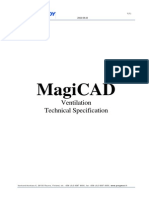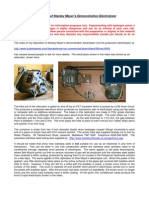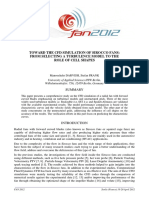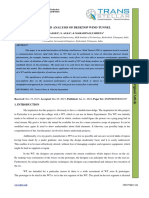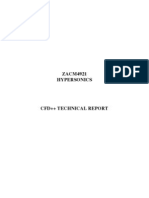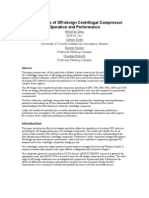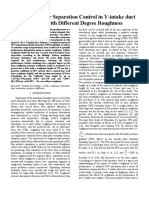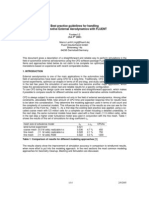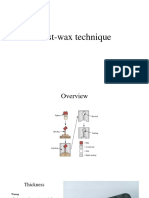Dynamic Analysis and Development of Card-Spinning System
Dynamic Analysis and Development of Card-Spinning System
Uploaded by
VaanazhaganCopyright:
Available Formats
Dynamic Analysis and Development of Card-Spinning System
Dynamic Analysis and Development of Card-Spinning System
Uploaded by
VaanazhaganOriginal Title
Copyright
Available Formats
Share this document
Did you find this document useful?
Is this content inappropriate?
Copyright:
Available Formats
Dynamic Analysis and Development of Card-Spinning System
Dynamic Analysis and Development of Card-Spinning System
Uploaded by
VaanazhaganCopyright:
Available Formats
DYNAMIC ANALYSIS AND DEVELOPMENT OF CARD-SPINNING SYSTEM
Investigators: Youjiang Wang (leader), Mary Lynn Realff, Radhakrishnaiah Parachuru, J.
Lewis Dorrity, Fred L. Cook, Jim Brazell, Xi Chen (Georgia Tech)
Bhuvenesh C. Goswami, David A. Zumbrunnen (Clemson)
Students: Shumin Zheng, Fan Zhao, Hua Huang (Georgia Tech)
Kai Liu, John Mike Wolf (Clemson)
PROJECT GOAL
The goal of this project is to create the fundamental knowledge needed to develop more efficient
machines and novel processes that can potentially decrease the number of process steps by a
factor of 2 to 3 in short staple yarn manufacturing.
ABSTRACT
To develop more efficient machines for short staple yarn manufacturing that can significantly
shorten the processing line, we are currently conducting research in the following two
interrelated areas: (1) to analyze the motion dynamics of fiber clumps and particles in an airflow
field, and (2) to develop a single-step process (Card-Spinning) to incorporate multiple spinning
heads into a carding unit. This involves a fundamental analysis and understanding of web
uniformity monitoring, measurement, and regulation, web division, and feeding of web ribbons
into yarn spinning heads positioned at the front end of the card.
We have built a prototype of the yarn spinning head system and have modified opening and
carding machines to demonstrate the concept. A series of yarns has been made with the spinning
head system by varying the process settings. Evaluation of these yarns indicates that the
technology is promising and further development is underway.
We have frequently interacted with our industrial partners including yarn producers and
machinery manufacturers to share information on the project and to learn the state of the art
practice in the industry. Studies are underway on theoretical and experimental analysis of
airflow, and on the development of the Card-Spinning system.
INTRODUCTION
In the past decades, yarn manufacturing has transformed from a labor intensive operation to a
capital intensive one. This change has allowed the US to remain competitive in the global
marketplace. Although the productivity of current manufacturing systems continues to increase,
National Textile Center Annual Report: November 2001
F98-G15
1
a significant improvement requires major breakthroughs and new innovations, which can only be
achieved with a better understanding of the fundamental principles of the processes.
Staple yarn manufacturing involves four essential operations: fiber separation, parallelization,
attenuation, and consolidation. Currently, several machines (about 10) in sequence are needed
for these tasks. We are developing the fundamental knowledge base that can lead to more
efficient machines, shorter production lines, and novel processes. Our first major task in this
project is the study of the motion dynamics of fiber clumps and particles in an airflow field. The
second major task aims at developing a novel process (Card-Spinning) by incorporating multiple
spinning heads on the carding machine itself.
AIRFLOW IN OPENING AND CLEANING
The opening and cleaning process is the first part in a staple yarn manufacturing line. It opens
fiber bales into small tufts, removes most of the impurities, and blends fibers together. Airflow
plays a very important role in determining the efficiency and quality of the opening/cleaning
operations. Fiber opening, cleaning, and transport in the opening and cleaning processes are
achieved through interactions among airflow, inertia forces, gravity, fiber/particle configurations,
barrier arrangements (mote knives, grid bars, plates, etc.), beating actions, carding actions,
among others. Although some studies have been conducted in this area (e.g., [1] on opening and
cleaning and [2,3,4] on carding), the depth has been limited due to the complexity of the
problem.
The airflow with particles and fibers in these processes is typically a two-phase, unsteady
viscous flow. Our studies include experimental analysis using flow visualization techniques and
computational fluid dynamics (CFD) analysis. The experiments were designed to determine the
effect of fibers on airflow pattern, and to determine the condition when fibers can be neglected in
a CFD analysis. Some of the test results have been used to build a two-phase flow model in
CFD. One of the uses for the model is for predicting the flow characteristics and improving the
design of textile machinery.
Test setup and pressure distribution
The test setup, shown in Figure 1, is designed so that the test section can be changed to obtain
typical flow patterns such as parallel, diverging, converging and flow over a bent section. It is an
enclosed system consisting of a fan, test section and connection pipes. The test section is a
rectangular channel (1.5 m X 0.15m X 0.31m), the top of which can be adjusted or replaced to
change the shape of the channel. It is built with plexiglass panels to enable flow visualization
using a high-speed video camera. Forty pressure sensors arranged in four rows are installed to
monitor the flow pattern.
National Textile Center Annual Report: November 2001
F98-G15
2
Pressure Distribution along X Dir.(V=28m/s)
-14.5
0 10 20 30 40
-15
Pressure (mmH2O)
-15.5
Bottom
-16
Z=76.2mm
-16.5 Z=152.4mm
Z=118.6mm
-17
X axis (inch)
Figure 1: Test setup for airflow studies Figure 2: Pressure distribution along the path
of the test setup predicted by CFD model.
The pressure in the test section was measured with the flow channel in the expansion type flow
configuration. With this configuration, a pressure increase should be seen along the flow
direction. The experimental results were compared to those of the CFD model (Figure 2). The
trends seen in the experimental results agreed well with those of the model, however, a
difference in the magnitude of the pressures was seen. The difference in magnitude was not of
concern, since a more meaningful comparison is done by looking at the slopes of the
experimental and model results. This comparison shows good agreement between the CFD
model and the experimental observations. Upon further investigation, a temperature increase
was observed in the test system. This causes a reduction in the density of air, which changes
flow rate. When the influence of this temperature increase is included in the modeling, the
results are only 12% different than the experimentally observed data.
Influence of amount of fiber in the flow and velocity of fibers in air flow
A series of tests were conducted to determine the sensitivity of the flow field to increases in the
amount of fiber present. The amount of fiber in the test setup was changed (approximately 35 g,
69 g, 98 g,119g and 141 g) for each series of experiments. To determine the velocity of fibers in
the airflow in the test section, a high-speed video camera is used to capture images of airflow
with a foam particle which is similar in dimensions to the fiber clumps. Results showed that the
velocity of the foam particle ranged from 7.52 to 16.8 m/sec with an average of 12.6 m/sec. The
average velocity of the air flow in the test setup without the particle was 11 m/sec. These results
have been analyzed and found to be reasonable.
In summary, we have built a test setup that captures many of the characteristics of flow fields
present in textile machinery. We have demonstrated that CFD models can be used to predict the
trends seen in the pressure distribution for the test setup for both air and air-fiber flow. The
trends in the experimental data for varying amounts of fiber in the flow were captured by the
model. However, the models do not predict the exact values of the pressures. Further
National Textile Center Annual Report: November 2001
F98-G15
3
development of the models will lead to better predictions of the experimental data. In the future,
the results of the models will be used to design new textile processing equipment.
CARDING
In a traditional process, carding individualizes fibers, removes fine impurities and neps, and
forms a sliver. By incorporating multiple spinning heads on the carding machine itself, the novel
Card-Spinning machine will replace the traditional card, two draw frames and the yarn-spinning
machine.
Web monitoring
One of the major problems in spinning multiple yarns directly from a card web is that the cross-
machine web density must be monitored and the divided sections must be controlled. Although
some studies on web uniformity have been conducted for nonwoven processes [5,6,7,8,9], there
is no available data on cross-machine uniformity for the card in yarn production line since the
web is typically condensed into a single sliver and only the overall linear density is important.
When one decides to split the web into multiple sections to feed directly to spinning heads, the
variability of the web takes on great importance.
A system has been integrated with the card to monitor the web density on-line. It employs a
computer, line-scan camera and high-speed frame grabber board (Figure 3). This system will
enable real-time monitoring across the full width of the web. This is important for monitoring
the input quality of the web to the yarn-spinning head. The system is capable of monitoring
100% of the web or just sampling a subset of the web. An image of the web is created line-by-
line with the scanning rate of the camera synchronized with the web motion when 100%
monitoring is required. In this way a picture of the web is obtained. For process monitoring and
control, a statistical sampling can be taken to analyze variation in any given section (strip) of
web. An extensive literature search did not find published data on web variability and this work
should add to the body of knowledge.
Web splitting
A proof-of-concept device has been designed and the first prototype was built. The principles
involve positive control of the web sections during division via belts that squeeze the web, and
through differential speeds, shear the web longitudinally in a short distance. Servomotors with
digital control were added to the device (Figure 4). Initially, the belts were divided into two
groups with slower and faster speeds, each set driven by one servomotor. It was found that the
slower motor’s speed was influenced due to frictional drags caused by the adjacent faster moving
pulleys. The device was then modified to use timing pulleys and belts to ensure an accurate
speed difference. Effort to synchronize the speeds of the web divider, card, and yarn spinning
heads is underway. When the concept is finalized, the apparatus can be easily expanded to 10 or
more strips. The limitation, of course, is in the uniformity of the web across the
National Textile Center Annual Report: November 2001
F98-G15
4
Line-Scan Camera
Carding
Splitting Device
Figure 3. Photograph of experimental setup of a card equipped with web slitting, web
monitoring and control devices. The carding machine with a fine opener and chute feed
is donated by American Truetzschler, our industry partner.
Figure 4. Web divider with servomotors and digital control
National Textile Center Annual Report: November 2001
F98-G15
5
machine. It is expected that uniformity of polyester staple fibers will produce a reasonably
uniform web. A cotton web would be much more of a challenge. The web will be made as
heavy as possible in order to create the linear density needed for a coarse yarn.
YARN FORMATION BY CARD-SPINNING
In a traditional staple yarn spinning system, fibers are opened, cleaned, carded, drawn and
reduced to a roving before spinning (twisting). One of the objectives of this project is to design a
system where the short staple fibers in the carded web can be spun directly into a yarn before the
web is consolidated into a sliver. A literature research (e.g., [10,11,12,13]) shows that efforts
have been made to shorten the systems to convert short staple (cotton type) fibers into yarns, and
that in the shortened systems, carded or drawn sliver is processed into either a ring spun, a rotor
spun or an air-jet spun yarn, thus eliminating the extra step of drawing and/or roving.
We have assembled a flexible "hybrid nozzle" spinning device with the objective of straightening
the fibers, twisting the bundle with high efficiency and low air consumption, and producing a
smooth and strong yarn. Figure 5 shows a schematic drawing of the spinning device, and Figure
6 shows a photograph of the device. The device is designed to have the maximum flexibility in
processing conditions. It is placed on a height-adjustable table with wheels. The speeds of the
feeding rollers, delivery rollers and the winder can be independently set.
In conventional airjet spinning machines, a draft system is used to draft and to feed the fiber
strand into the spinning nozzle. For example, MJS801 air-vortex spinning machine by Murata
has 3-roll drafting system while MJS802 has a 4-roll system. In our Card-Spinning system,
because the card web is split to provide the necessary linear density, there is no need to draft the
web ribbon. Therefore, a pair of normal feeding rollers are used to control the rate of feeding the
web ribbon into the spinning nozzle. The vortex air spinning unit is composed of a Murata 802
MJS, twin air jet spinning nozzle, and utilizes a service air system. A negative air pressure is
formed in the first nozzle to aspirate the fiber sliver. The second nozzle twists the outer fibers
free from fiber core to wrap around the core and form a yarn. A pair of delivery rollers and a
winder is used to wind the yarn into a cone shape that is suitable for further experimental tests
and production.
Before this spinning device is directly attached to the web splitting device under development
(see previous section), we tested its operation by feeding it with separately prepared thin slivers.
The feed strand is aspirated into the spinning unit via a transfer channel. The fiber bundle is
twisted to form a yarn, which is then wound onto a paper cone.
In a conventional air-jet spinning process, drawn slivers are used as the feeding stock. Whereas
for the Card-Spinning device, card web will be fed to the spinning device directly. To study the
effect of feed stock, we have conducted a study to compare the yarn characteristics using both
drawn sliver and card sliver as the feed material. The feed slivers, of the same linear density,
were fed into our spinning device to produce yarns under the same spinning parameters: air-
National Textile Center Annual Report: November 2001
F98-G15
6
Deliver
Roller Winder
Feeding
Roller
8.48 49cm
Control
Box
90cm
Feed roller Winder
Motor Motor
56cm Condensing Roller
Deliver Roller
Doffer Motor
Figure 5. schematic drawing of the spinning device
Figure 6. Photograph of the spinning
device
pressure of spinning nozzles, feed speeds, delivery speeds and windup speeds. The analysis on
the final yarns shows that yarns spun from card sliver are not as uniform as that of yarns from
drawn sliver. However, the card sliver, due to its loose structure, is easier to twist.
The main factors influencing the final yarn qualities include: super feeding ratio (affecting
winding tension); condenser size; distance from front roll to spinning nozzle and air pressures.
Three air-pressure conditions and two super feeding ratios were used to produce yarns with
drawn sliver and card sliver (Table 1). The effect of feed ratio, pressure ratio, and feeding stock
on yarn breaking strength is shown in Figure 7.
For the carded sliver yarns, a nozzle pressure ratio of 0.57 yielded a yarn with better final yarn
quality than the yarn produced with other ratios. For example, the tensile strength of yarns with
National Textile Center Annual Report: November 2001
F98-G15
7
Table 1. Yarn spinning parameters: Nozzle pressures (N1, N2) and draft ratios (K1,K2,K3)
for yarns produced from card sliver and drawn sliver.
Yarns N1 N2 P= K1 = .97 K2 = .98 K3 = 1.04
(psi) (psi) N1/N2
Yarn From 60 20 0.57 Yarn_001 Yarn_002 Yarn_003
Card Sliver 40 70 3.0 Yarn_005 Yarn_006 Yarn_007
50 28 1.78 Yarn_009 Yarn_010 Yarn_011
Yarn From 60 20 57 Yarn_101 Yarn_102 Yarn_103
Drawing 40 70 3.0 Yarn_105 Yarn_106 Yarn_107
50 28 1.78 Yarn_109 Yarn_110 Yarn_111
P= 0.57 ranged from 1.6 to 2.0 kgf, while those produced with P = 1.78 and P = 3.0 were
significantly weaker (0 to 0.5 kgf). Yarn elongation and tenacity exhibited a similar trend.
For the drawn sliver yarns, a value of P=1.78 yielded the highest tenacity and elongation. A feed
ratio of 0.98 was shown to produce the highest quality yarns.
In analyzing the effects of drawing on yarn characteristics, it was shown that for P ratios of 1.78
and 3.0, the drawn sliver produces a better quality of yarn. However, for P = 0.57, the carded
sliver yields better yarn quality. This was determined by evaluating the yarn strength, yarn
elongation and yarn tenacity. This result is significant. It means that if the fiber alignment and
desired regularity of a sliver are achieved by carding machine modification, the spinning of yarn
directly from carded web may be practical. The expensive drawing process could then be
eliminated from the staple yarn production line. Further details are presented in the thesis
derived from this systematic study of processing parameters [14].
SUMMARY
This project focused on the motion dynamics of fiber clumps in an airflow field and the
development of a prototype Card-Spinning unit, which combines carding and yarn spinning in a
single machine. We have demonstrated its feasibility in producing coarse yarns. Continuing
effort is underway on experimental and theoretical analysis of air flow, web uniformity
regulation, system integration/enhancement, and yarn characteristics studies.
We are pleased that the project has received significant interest and support from the textile and
the machinery industries. The interaction with industrial partners plays a significant role in the
success of this project.
National Textile Center Annual Report: November 2001
F98-G15
8
P=3 (N1=60, N2=30 psi)
breaking Load(kgf)
0.8
0.6
Card
0.4
Drawing
0.2
0
0.97 0.98 1.04
Feed Ratio
P=1.785 (N1=50, N2=28 psi)
breaking Load(kgf)
0.8
0.6
Card
0.4
Drawing
0.2
0
0.97 0.98 1.04
Feed Ratio
P=0.57 (N1=40, N2=70 psi)
breaking Load(kgf)
2.5
2
1.5 Card
1 Drawing
0.5
0
0.97 0.98 1.04
Feed Ratio
Figure 7. Effect of feed ratio, pressure ratio, and feeding stock on yarn breaking strength
REFERENCES
1 W. Bostock, S.M. Freeman, S.A. Shorter and T.C. Williams, “An aerodynamical study of
the opening and cleaning of cotton by existing machinery”, J. Tex. Inst., 1955, T171-190.
2 P.M. Strang, “Air shearing force separates fibers”, Am. Wool & Cotton Reporter, August
1949, p12.
National Textile Center Annual Report: November 2001
F98-G15
9
3 G. Merenyi, “Methods of control of strips and effect of air currents in carding”, Tex.
Manufacturer, 1957, p27.
4 A.L. Miller, R.S. Brown, and R.A. Ruca, “An investigation of air pressures in the cotton
carding machine”, Tex. Res. J., July 1958, p593.
5 P. Boeckerman, “Meeting the Special Requirements for On-line Basis Weight
Measurement of Lightweight Nonwoven Fabrics” TAPPI Nonwovens Conference, 1992
169.
6 L. Crook, and K. Staats, “Carded Webs—An Overview of Methods Used to Produce
Parallel and Random Webs for Print Bonding and Thermal Bonding” TAPPI Nonwovens
Conference, 1984, p21.
7 T.R. Wan, G.A.V. Leaf, C. Iype, “A New Objective Method for Assessing Fibre
Arrangement in Fibrous Webs.” J. Text. Inst. 86 No. 4, 1995, p649.
8 A. Cherkassky, “Analysis and Simulation of Nonwoven Irregularity and
Nonhomogeneity.” Textile Res. J. 68(4), 1998, p242.
9 R.K. Aggarwal, W.R. Kennon, and I. Porat, “A Scanned-laser Technique for monitoring
Fibrous Webs and Nonwoven Fabrics.” J. Text. Inst. 83 No.3, 1992, p386.
10 E. Pallay, "Method of and apparatus for spinning yarn in an air vortex in a Spinning tube",
USA patent: 4174605, Nov, 20,1979
11 S. Didek, L. Fajt, M. Reymanova, M. Markova, "Method of and apparatus for spinning
yarn from staple fibers in an air vortex", USA patent:4553383,Nov 19 ,1985.
12 D. A. Bahov, H. A. Bahov, "Vortex air nozzle for yarn spinning from staple fibers". USA
patent: 4689948,Sep, 1,1987.
13 H. Stadler, R. Ammann, "Method of producing a rotating air layer and false-twist air jet
nozzle for practicing such method", USA patent: 4934133, Jun 19,1990.
14 Kai Liu, “Yarn Spun Directly from the Card,” MS Thesis, Clemson University, December
2000.
Project Web Site
http://www.tfe.gatech.edu/faculty/wang/CardSpin/
National Textile Center Annual Report: November 2001
F98-G15
10
You might also like
- MagiCAD Ventilation CalculationsDocument20 pagesMagiCAD Ventilation CalculationsAdrian David100% (1)
- Water Fuel Cell - Build Manual - Tap Water (Daves Stanley Meyer Xogen Free Energy)Document10 pagesWater Fuel Cell - Build Manual - Tap Water (Daves Stanley Meyer Xogen Free Energy)andr3y775% (4)
- Folding and PackingDocument27 pagesFolding and PackingVaanazhagan50% (2)
- Different Types of Feeding Mechanism in Sewing MachinesDocument21 pagesDifferent Types of Feeding Mechanism in Sewing MachinesVaanazhaganNo ratings yet
- Seams and StitchesDocument21 pagesSeams and StitchesVaanazhaganNo ratings yet
- Turbo 141 01 011011Document11 pagesTurbo 141 01 011011Navdeep SinghNo ratings yet
- Toward The CFD Simulation of Sirocco Fans: From Selecting A Turbulence Model To The Role of Cell ShapesDocument12 pagesToward The CFD Simulation of Sirocco Fans: From Selecting A Turbulence Model To The Role of Cell ShapesGuyfawkesNo ratings yet
- Evaluating Complex Inlet Distortion With A Parallel Compressor Model Part 1Document19 pagesEvaluating Complex Inlet Distortion With A Parallel Compressor Model Part 1Lam Trinh NguyenNo ratings yet
- 2019 - IJFTE - Mehul CD NozzleDocument6 pages2019 - IJFTE - Mehul CD NozzleMehul BambhaniaNo ratings yet
- Model and Analysis of Desktop Wind Tunnel: Md. Khaleel, S. Alka, & Marampalli ShilpaDocument8 pagesModel and Analysis of Desktop Wind Tunnel: Md. Khaleel, S. Alka, & Marampalli ShilpaTJPRC PublicationsNo ratings yet
- ZACM4921 HypersonicsDocument9 pagesZACM4921 HypersonicsChowkidar KarthikNo ratings yet
- Flow Rate Control During Vacuum-Assisted Resin Transfer Molding (VARTM) ProcessingDocument7 pagesFlow Rate Control During Vacuum-Assisted Resin Transfer Molding (VARTM) ProcessingouaireNo ratings yet
- Optimizing Impeller GeometryDocument7 pagesOptimizing Impeller GeometryDanang JoyoeNo ratings yet
- Comparative Study of Various Parameter of ESP by Using CFD: AbstractDocument9 pagesComparative Study of Various Parameter of ESP by Using CFD: AbstractAnonymous 9NqiyRj8ENo ratings yet
- Flow Simulations of An Axial Transonic Compressor Stage: January 2009Document14 pagesFlow Simulations of An Axial Transonic Compressor Stage: January 2009Adel AyoubNo ratings yet
- 2651-Article Text-11254-1-10-20180721Document10 pages2651-Article Text-11254-1-10-20180721Faisal RahmanNo ratings yet
- Numerical and Experimental Investigation On A Conical Poppet Relief Valve With Flow Force CompensationDocument13 pagesNumerical and Experimental Investigation On A Conical Poppet Relief Valve With Flow Force CompensationSasko DimitrovNo ratings yet
- CFD Modelling of Supersonic Airflow Generated by 2D NozzleDocument7 pagesCFD Modelling of Supersonic Airflow Generated by 2D NozzleSkanda HebbarNo ratings yet
- CFD Analysis of Swept and Leaned Transonic Compressor RotorDocument5 pagesCFD Analysis of Swept and Leaned Transonic Compressor RotorseventhsensegroupNo ratings yet
- CFD Analysis of Off-Design Centrifugal CompressorDocument16 pagesCFD Analysis of Off-Design Centrifugal CompressorutcNo ratings yet
- UPVCcalibration ExperimentalDocument12 pagesUPVCcalibration ExperimentalM SaundersNo ratings yet
- Advanced CFD Tools For Multi-Stage Turbine Analysis: AlgebraicDocument12 pagesAdvanced CFD Tools For Multi-Stage Turbine Analysis: AlgebraicEr M HnNo ratings yet
- 2017 - Lorenzo Cassi - Computational Fluid Dynamics Rns Rbs TDocument11 pages2017 - Lorenzo Cassi - Computational Fluid Dynamics Rns Rbs Talireza.mohseni1996No ratings yet
- Effect of Changing Arm Pressure of Drafting Zone of A Roving Frame On Yarn QualityDocument11 pagesEffect of Changing Arm Pressure of Drafting Zone of A Roving Frame On Yarn QualityMd. Humayun KabirNo ratings yet
- Processes 08 01445 v2Document20 pagesProcesses 08 01445 v2dungdechoi258No ratings yet
- C.R. Siqueira - 3d Transient Simulation of An Intake Manifold CFD - SAE 2006-01-2633Document7 pagesC.R. Siqueira - 3d Transient Simulation of An Intake Manifold CFD - SAE 2006-01-2633Thomas MouraNo ratings yet
- Fluid Flow Analysis of Centrifugal Fan by Using FemDocument7 pagesFluid Flow Analysis of Centrifugal Fan by Using FemIAEME PublicationNo ratings yet
- GT2020 16204 Original TE Paper HP LHDocument15 pagesGT2020 16204 Original TE Paper HP LHhoomanNo ratings yet
- Nomogramas Perry Transp NeumáticoDocument6 pagesNomogramas Perry Transp NeumáticoIvo AsturiasNo ratings yet
- Load Carrying Capacity and Failure Mode of 3D Printing Mortar Wall Panel Under Axial Compression Loading RevisedDocument12 pagesLoad Carrying Capacity and Failure Mode of 3D Printing Mortar Wall Panel Under Axial Compression Loading RevisedRocketer OatrocketerNo ratings yet
- Mau Tinh Toan Va Can Chinh Duong OngDocument36 pagesMau Tinh Toan Va Can Chinh Duong OngTuấn NguyễnNo ratings yet
- Verification of Laminar and Validation of Turbulent Pipe FlowsDocument56 pagesVerification of Laminar and Validation of Turbulent Pipe FlowsARABONo ratings yet
- Inverse Engineering and Preliminary Simulation of A Closed Profile Roll-Forming LineDocument8 pagesInverse Engineering and Preliminary Simulation of A Closed Profile Roll-Forming LinebkhmohamedNo ratings yet
- Pressure Losses in Multiple-Elbow Paths and in V-Bends of Hydraulic ManifoldsDocument20 pagesPressure Losses in Multiple-Elbow Paths and in V-Bends of Hydraulic ManifoldsRugved DamleNo ratings yet
- 94 GT 126Document12 pages94 GT 126Ivan MagriniNo ratings yet
- Boundary Layer Separation Control in Y-Intake Duct Adapter With Different Degree RoughnessDocument12 pagesBoundary Layer Separation Control in Y-Intake Duct Adapter With Different Degree Roughnessfatimah malekNo ratings yet
- مقاله کمکی 3Document5 pagesمقاله کمکی 3korope8705No ratings yet
- External AerodynamicsDocument14 pagesExternal AerodynamicsBharath Dv100% (1)
- CFD Analysis of A 15 Stage CompressorDocument2 pagesCFD Analysis of A 15 Stage Compressoralagarg137691No ratings yet
- Please Dont Delete1Document4 pagesPlease Dont Delete1Sayee ChandrasekaramouliNo ratings yet
- Optimization of Turbo Machinery Validation Against Experimental ResultsDocument13 pagesOptimization of Turbo Machinery Validation Against Experimental ResultsSrinivasNo ratings yet
- Vortex PDFDocument6 pagesVortex PDFSourabh JainNo ratings yet
- Computational Fluid Dynamics Simulation of Structured PackingDocument14 pagesComputational Fluid Dynamics Simulation of Structured PackingAndrea Ramírez GarcíaNo ratings yet
- Extraction Columns.: Proceedings PaperDocument10 pagesExtraction Columns.: Proceedings PaperAnonymous q1gGEpNo ratings yet
- Axial Turbine Stages Design 1D 2D 3D Simulation Experiment OptimizationDocument10 pagesAxial Turbine Stages Design 1D 2D 3D Simulation Experiment OptimizationAditya SawantNo ratings yet
- Salcedoss@inta - Es Mongef@inta - Es Palaciosg@inta - Es Fgandia@upm - Es Angel - Rodriguez.sevillano@upm - EsDocument7 pagesSalcedoss@inta - Es Mongef@inta - Es Palaciosg@inta - Es Fgandia@upm - Es Angel - Rodriguez.sevillano@upm - EsBruno AlvesNo ratings yet
- 049 FrankDocument12 pages049 FrankMaroknightNo ratings yet
- A Review of Inlet-Fan Coupling MethodologiesDocument11 pagesA Review of Inlet-Fan Coupling MethodologiesAli CiritNo ratings yet
- SPE 21279 Yield Points in Oilfield Cement Slurries: P.E. Clark, L. Sundaram, and M. Balakrishnan, U. AlabamaDocument7 pagesSPE 21279 Yield Points in Oilfield Cement Slurries: P.E. Clark, L. Sundaram, and M. Balakrishnan, U. AlabamamuhamadfadhilhamidNo ratings yet
- Comparative Study of Various Parameter of ESP by Using CFD: AbstractDocument9 pagesComparative Study of Various Parameter of ESP by Using CFD: AbstractSylvesterNo ratings yet
- 2015 99 HellerDocument17 pages2015 99 HellerViet LeNo ratings yet
- Flow Forming: A Review of Research Methodologies, Prediction Models and Their ApplicationsDocument31 pagesFlow Forming: A Review of Research Methodologies, Prediction Models and Their Applications임학진No ratings yet
- CFD FMDocument5 pagesCFD FMRahul RahulNo ratings yet
- Scalar Pneumatic ConveyingDocument11 pagesScalar Pneumatic ConveyingHeiderHuerta100% (1)
- Air-Flow in Multi-Stage Centrifugal CompressorDocument18 pagesAir-Flow in Multi-Stage Centrifugal Compressorqu20awareNo ratings yet
- Intermediate Lab 1 ManualDocument53 pagesIntermediate Lab 1 ManuallppeaceNo ratings yet
- Process Control for Sheet-Metal Stamping: Process Modeling, Controller Design and Shop-Floor ImplementationFrom EverandProcess Control for Sheet-Metal Stamping: Process Modeling, Controller Design and Shop-Floor ImplementationNo ratings yet
- Modelling of Vibrations of Overhead Line Conductors: Assessment of the TechnologyFrom EverandModelling of Vibrations of Overhead Line Conductors: Assessment of the TechnologyGiorgio DianaNo ratings yet
- Estimator's Piping Man-hours Tool: Estimating Man-hours for Carbon Steel Process Piping Projects. Manual of Man-hours, ExamplesFrom EverandEstimator's Piping Man-hours Tool: Estimating Man-hours for Carbon Steel Process Piping Projects. Manual of Man-hours, ExamplesNo ratings yet
- Comber: Salient FeaturesDocument2 pagesComber: Salient FeaturesVaanazhagan100% (5)
- Lapformer lh15Document2 pagesLapformer lh15VaanazhaganNo ratings yet
- Recent Developments in Spinning, Weaving and Wet Processing Industry - Textile LearnerDocument10 pagesRecent Developments in Spinning, Weaving and Wet Processing Industry - Textile LearnerVaanazhaganNo ratings yet
- Multiple Activity Chart: Group - 1Document27 pagesMultiple Activity Chart: Group - 1VaanazhaganNo ratings yet
- Draw Frame: Salient FeaturesDocument2 pagesDraw Frame: Salient FeaturesVaanazhaganNo ratings yet
- Two Handed Process Chart & Ergonomics in Textile and ApparelDocument32 pagesTwo Handed Process Chart & Ergonomics in Textile and ApparelVaanazhaganNo ratings yet
- Recent Developments in Ring SpinningDocument4 pagesRecent Developments in Ring SpinningVaanazhaganNo ratings yet
- Group 7Document28 pagesGroup 7VaanazhaganNo ratings yet
- Economics Unit 5 - 1457145468349Document5 pagesEconomics Unit 5 - 1457145468349VaanazhaganNo ratings yet
- String Diagram and Plant Layout: Group - 2Document25 pagesString Diagram and Plant Layout: Group - 2VaanazhaganNo ratings yet
- Comparison of Markets Structures - 1458613952630Document2 pagesComparison of Markets Structures - 1458613952630VaanazhaganNo ratings yet
- Economics Unit 6 - 1457605509458Document9 pagesEconomics Unit 6 - 1457605509458VaanazhaganNo ratings yet
- Types of Fabric UsedDocument17 pagesTypes of Fabric UsedVaanazhaganNo ratings yet
- Computerized Pattern MakingDocument18 pagesComputerized Pattern MakingVaanazhaganNo ratings yet
- Buying House & Buying AgenciesDocument17 pagesBuying House & Buying AgenciesVaanazhagan0% (1)
- Mechanics CA 3Document27 pagesMechanics CA 3VaanazhaganNo ratings yet
- Mechanics CA 2Document50 pagesMechanics CA 2VaanazhaganNo ratings yet
- HTFF525AS HTFF525AW User ManualDocument19 pagesHTFF525AS HTFF525AW User ManualUEENo ratings yet
- Punch Strech TestDocument11 pagesPunch Strech Testschool boyvsNo ratings yet
- Introduction CaeDocument11 pagesIntroduction Caefarais89No ratings yet
- G-Iii: Operation and Service ManualDocument74 pagesG-Iii: Operation and Service ManualNell StockNo ratings yet
- 3.2.1 Square FootingDocument32 pages3.2.1 Square FootingNeil SonNo ratings yet
- Lecture 4 - Color and Dielectric Properties of AB MaterialsDocument38 pagesLecture 4 - Color and Dielectric Properties of AB MaterialsjohnrafaeltrementizoNo ratings yet
- MAM Technical SpecificationDocument21 pagesMAM Technical SpecificationHendrias Ari SujarwoNo ratings yet
- Grillage Analogy MethodDocument43 pagesGrillage Analogy Methodkhx2No ratings yet
- Power TrainDocument257 pagesPower TrainStorm SpiritNo ratings yet
- Lost-Wax TechniqueDocument31 pagesLost-Wax TechniqueammarkochiNo ratings yet
- Hds Osai Gcode GuideDocument0 pagesHds Osai Gcode GuideRaymond LO OtucopiNo ratings yet
- General Physics 1 - 12 - q2 - m4Document16 pagesGeneral Physics 1 - 12 - q2 - m4antoinnevongenesis0% (1)
- Fluidization and Its Applications To Food ProcessingDocument18 pagesFluidization and Its Applications To Food ProcessingAnonymous yPWi8p3KkANo ratings yet
- V73No3P7 C1551 OSP HouDocument24 pagesV73No3P7 C1551 OSP HouAnh NgoNo ratings yet
- Total Hydrostatic Pressure: P Ha I e AyDocument2 pagesTotal Hydrostatic Pressure: P Ha I e AyJocelyn Cabarles100% (1)
- Richter ISRR13Document16 pagesRichter ISRR13AmanNo ratings yet
- 3level Full Factorial DesignDocument7 pages3level Full Factorial DesignKervin B. UntalanNo ratings yet
- Lecture Notes - Angles and Angle MeasureDocument2 pagesLecture Notes - Angles and Angle MeasureabercrombieNo ratings yet
- Nickel 212Document12 pagesNickel 212bkapur25No ratings yet
- Earthquake Analysis Method of Analysis: Structural Analysis and Design of A 2B+G+M+15 Office BuildingDocument11 pagesEarthquake Analysis Method of Analysis: Structural Analysis and Design of A 2B+G+M+15 Office BuildingephremNo ratings yet
- Driven Plate Anchors For Mooring Caissons PDFDocument8 pagesDriven Plate Anchors For Mooring Caissons PDFthadikkaranNo ratings yet
- Magnetic Effects Class 10 Cbse NotesDocument20 pagesMagnetic Effects Class 10 Cbse NotesAsmita PandeyNo ratings yet
- Mass SpectraDocument18 pagesMass SpectraMoustafa ElsadanyNo ratings yet
- Lecture 2 - Machine DesignDocument35 pagesLecture 2 - Machine Designmithunsingh90No ratings yet
- Aldehydes and KetonesDocument25 pagesAldehydes and KetonesShaira Mae Cuevillas0% (1)
- ChemE 150A Spring 2003 FinalDocument10 pagesChemE 150A Spring 2003 FinalwhateverpplsNo ratings yet
- Power System Analysis: Development of Transmission Line Models Tom Overbye and Ross BaldickDocument40 pagesPower System Analysis: Development of Transmission Line Models Tom Overbye and Ross BaldickscribsunilNo ratings yet
- MAT1332 Midterm 2014 PracitceDocument2 pagesMAT1332 Midterm 2014 Pracitceexamkiller100% (1)
- AISC - Inspection of Welded and Bolted JointsDocument26 pagesAISC - Inspection of Welded and Bolted JointsAdisak AumpiemNo ratings yet
